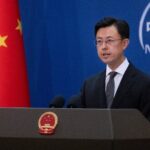US Signals Potential Shift in Ukraine-Russia Peace Efforts
April 18, 2025
WASHINGTON — The United States may be preparing to adjust its approach to Ukraine-Russia peace negotiations, according to recent statements from political figures involved in the diplomatic process. While the Biden administration has consistently supported Ukraine since Russia’s 2022 invasion, changing dynamics on the battlefield and within international diplomatic circles appear to be influencing Washington’s strategy.
Clarifying US Diplomatic Positions.
Senator Marco Rubio, who serves on the Senate Foreign Relations Committee, has reportedly expressed that the US might be prepared to “move on” from current peace negotiation efforts if substantive progress isn’t achieved within days. However, it’s important to note that Senator Rubio is not the Secretary of State, and his statements represent his position as a senior legislator rather than official State Department policy.
The State Department, which directs American diplomatic efforts under Secretary Antony Blinken, has maintained that finding a path to peace remains a priority, though the specifics of any deadline or American withdrawal from negotiation efforts have not been officially confirmed.
“The United States continues to support a just and durable peace in Ukraine that respects Ukrainian sovereignty and territorial integrity,” said a State Department spokesperson in a recent briefing. “We remain engaged with all parties to find diplomatic solutions.”
Evolving Peace Negotiation Landscape
Peace negotiations between Ukraine and Russia have followed a complex and often halting path since the full-scale invasion began in February 2022. Early talks in Belarus and Turkey yielded little progress, with fundamental disagreements over territory, security guarantees, and Ukraine’s future relationship with Western institutions.
By 2024, the conflict had evolved into what many analysts described as a war of attrition, with a relatively stable front line but ongoing fighting and civilian casualties. This military stalemate created both opportunities and challenges for negotiators.
International peace initiatives have come from various sources, including:
- China’s position paper on political settlement
- The Swiss-hosted peace conference process
- Mediation efforts by countries like Turkey, Qatar, and Brazil
- Various European diplomatic initiatives
Ukrainian President Volodymyr Zelenskyy has consistently advocated for a peace formula that includes complete Russian withdrawal from Ukrainian territory, accountability for war crimes, and security guarantees for Ukraine.
Russia, meanwhile, has maintained positions that most Western analysts view as untenable, including recognition of its claimed annexations of Ukrainian territory and restrictions on Ukraine’s sovereignty regarding military and foreign policy choices.
US Strategic Calculations
If the United States is indeed considering a shift in its approach to peace negotiations, several factors may be influencing this decision:
Resource Allocation: The prolonged conflict has required sustained American military and financial assistance to Ukraine, which faces competing priorities both domestically and internationally.
Political Considerations: The administration must balance support for Ukraine with other foreign policy objectives and domestic concerns about the extent and duration of American involvement.
Negotiation Dynamics: After multiple rounds of talks with limited progress, reassessment of diplomatic strategies is a standard practice in international relations.
Regional Stability: The ongoing conflict continues to impact European security architecture, global food security, and international economic stability.
“The US has been patient, but patience isn’t infinite in diplomacy,” explains Dr. Sarah Mendelson, former US Ambassador to the UN Economic and Social Council. “Sometimes signaling a potential shift in approach is itself a negotiating tactic to create momentum.”
Congressional Perspectives
Senator Rubio’s reported statements reflect broader discussions within Congress about the appropriate levels and conditions of US support for Ukraine. While there has been strong bipartisan backing for Ukraine, different voices have emerged regarding the path forward.
Some legislators have advocated for increased pressure on both sides to reach a negotiated settlement, while others emphasize the importance of not pressuring Ukraine to accept unfavorable terms.
“We need to be realistic about what can be achieved diplomatically while also holding firm to our principles,” said Representative Gregory Meeks, a senior member of the House Foreign Affairs Committee, in a recent committee hearing. “Ukrainian sovereignty and territorial integrity remain non-negotiable.”
International Reactions
America’s European allies have closely monitored any shifts in US positioning on Ukraine. NATO countries have generally maintained strong support for Ukraine while simultaneously exploring diplomatic avenues to end the conflict.
“We coordinate closely with our American partners on all aspects of the Ukraine crisis,” said a European Commission spokesperson. “Any recalibration of diplomatic strategies would be discussed through established channels of communication.”
Ukrainian officials have consistently emphasized that any peace negotiations must respect their country’s sovereignty and territorial integrity. President Zelenskyy has repeatedly stated that Ukraine will not accept peace at any price, particularly one that rewards Russian aggression.
Russia, for its part, has frequently accused the United States of prolonging the conflict by supporting Ukraine militarily. Russian diplomatic representatives have argued that Washington holds significant influence over Kyiv’s negotiating positions.
Expert Analysis
Foreign policy analysts see the potential shift in US approach as part of a broader diplomatic strategy rather than abandonment of Ukraine.
“Setting deadlines or creating a sense of urgency is a classic negotiating tactic,” notes Dr. Angela Stent, a Georgetown University professor and expert on US-Russia relations. “It can serve to focus minds and break through entrenched positions.”
Others suggest that the US may be preparing to apply more pressure on both sides to compromise.
“After years of conflict, the US may be calculating that the time has come to push harder for realistic concessions from both Moscow and Kyiv,” explains Michael Kimmage, professor at Catholic University and former State Department official responsible for Ukraine policy. “That doesn’t mean abandoning core principles, but it might mean accepting that perfect outcomes are unattainable.”
Path Forward
If the United States does adjust its approach to Ukraine-Russia peace negotiations in the coming days, several scenarios could unfold:
- Intensified diplomatic efforts with clear benchmarks for progress
- Greater multilateralization of peace initiatives, with increased roles for other international actors
- More direct pressure on both parties to compromise on specific issues
- A shift toward long-term management of the conflict rather than immediate resolution
What seems certain is that any substantive peace agreement would require addressing fundamental issues including territorial control, security arrangements, reconstruction financing, and integration of Ukraine into European and transatlantic structures.
“Peace processes rarely follow a linear path,” observes Ambassador William Taylor, former US Ambassador to Ukraine. “Sometimes what looks like stepping back is actually creating space for other approaches to succeed.”
As events unfold in the coming days, the international community will be watching closely for signals from Washington, Kyiv, and Moscow about whether meaningful progress toward peace remains possible in the near term.





